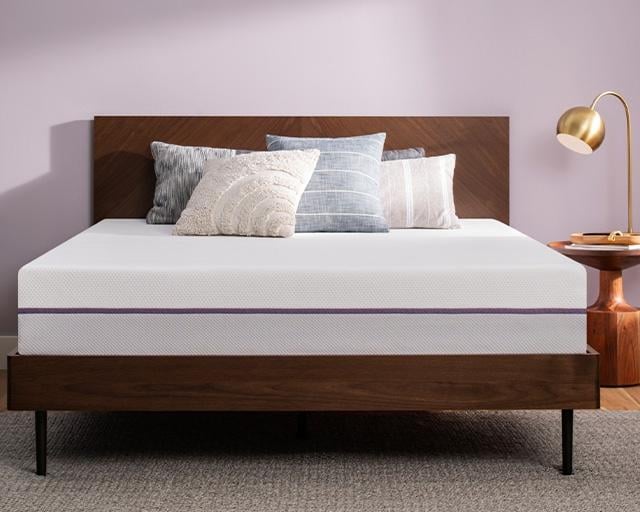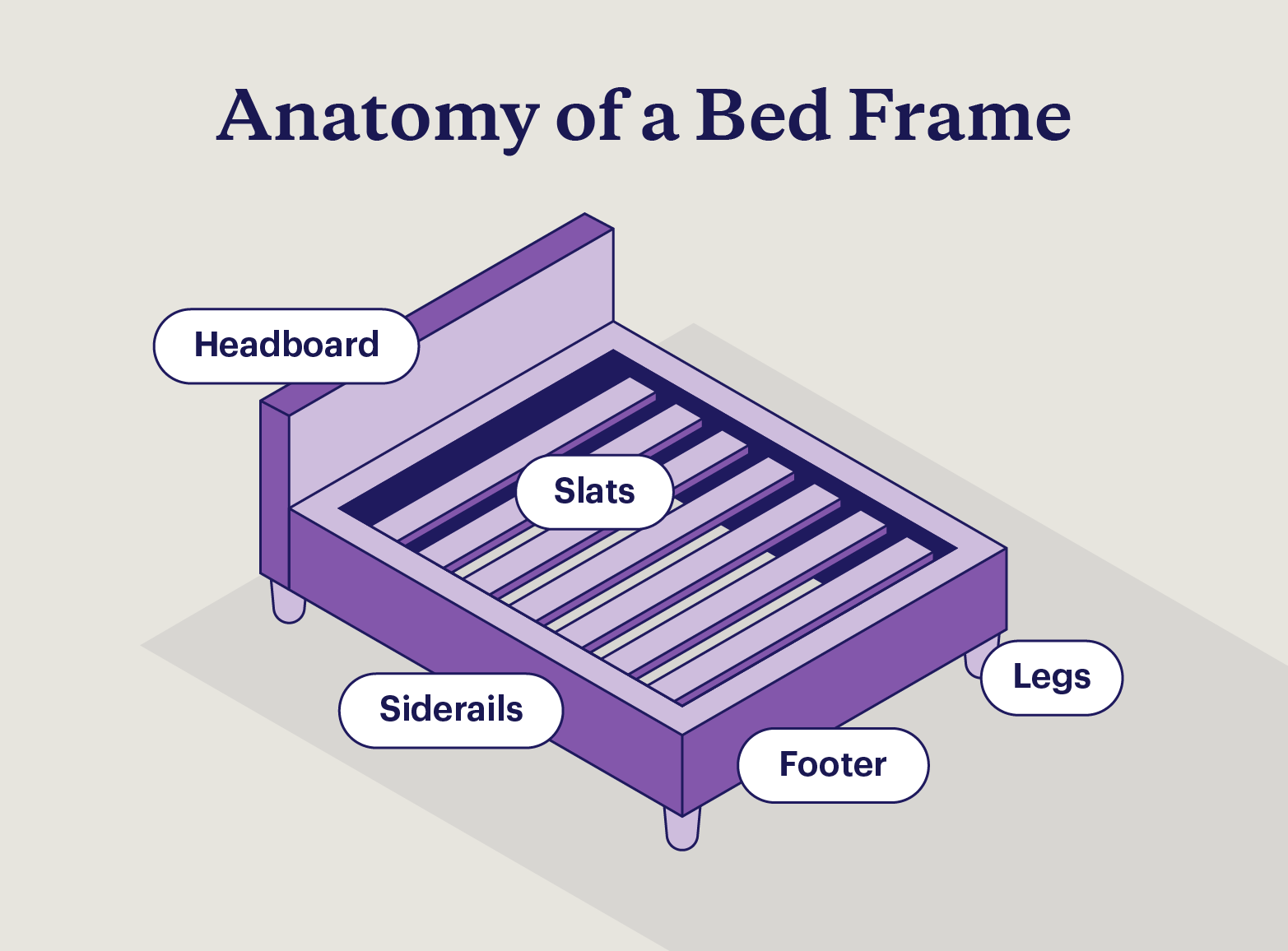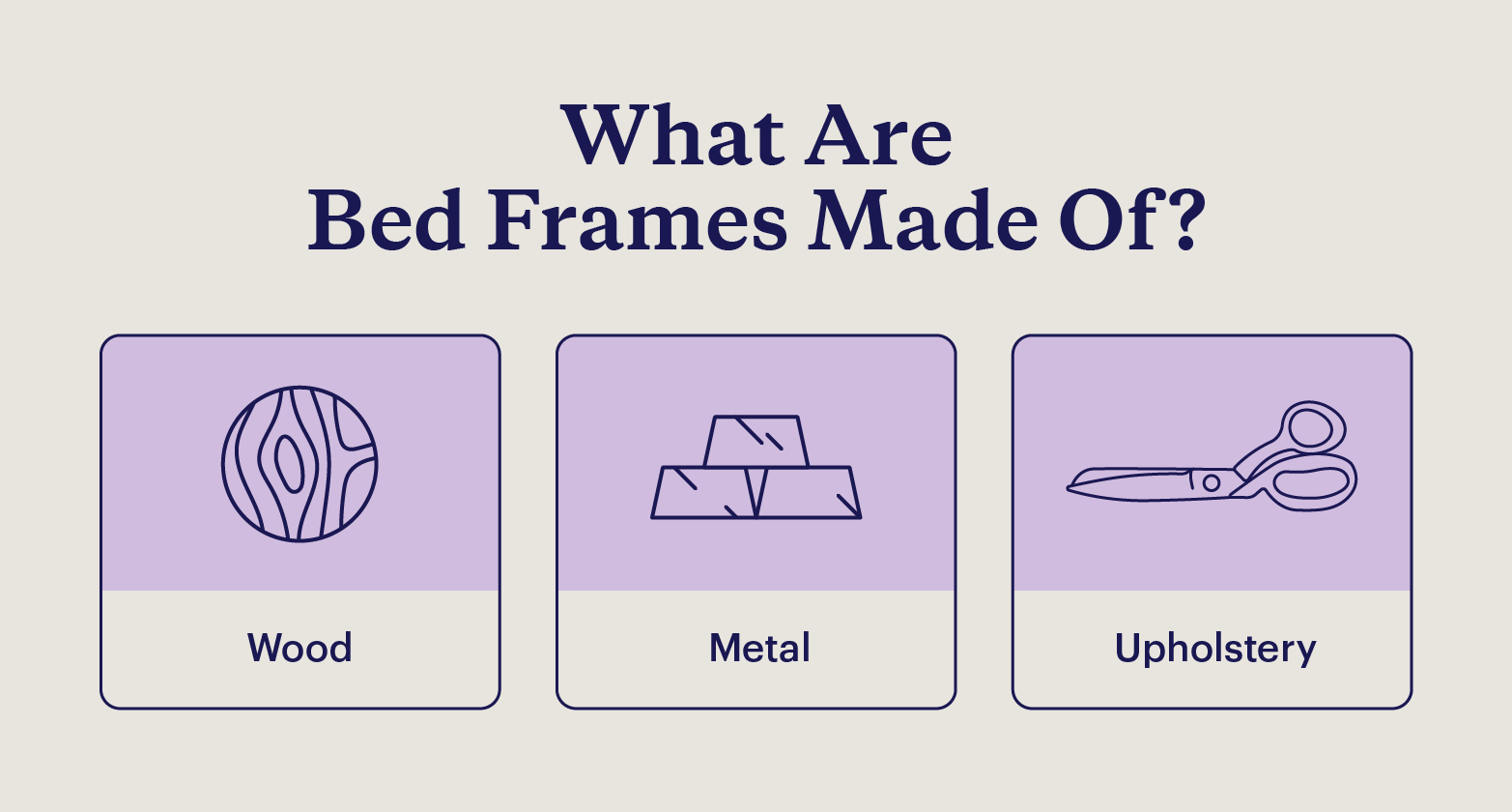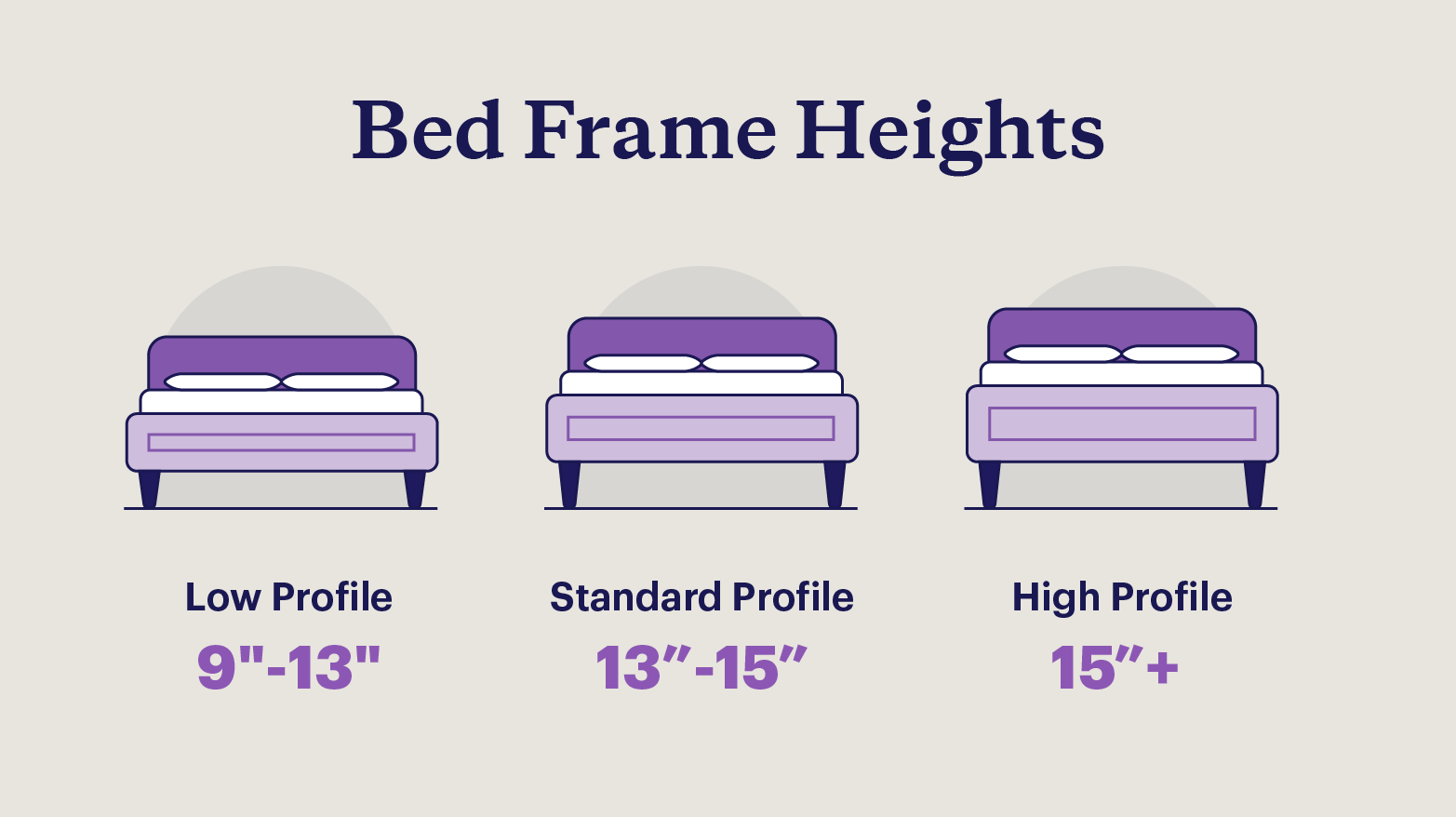What Is a Bed Frame + Do You Need One? All You Need To Know
Key Takeaways:
- A bed frame is a flat base that supports your mattress and elevates it off the floor for ease of getting in and out of bed.
- Bed frames create a more hygienic sleep space by keeping mattresses away from allergens, dirt, and other irritants that accumulate on floors and carpets. They also allow airflow underneath a mattress to prevent mold by mitigating built-up moisture.
- Bed frames come in numerous styles — each with specific features, aesthetics, and support requirements. They typically are made from wood and metal, though some have fabric accents.
Like mattresses, bed frames are crucial in providing the proper support you need each night. A frame is a functional or decorative piece of furniture that lifts a mattress off the floor for support.
Bed frames come in dozens of varieties and styles, which can make the shopping experience overwhelming. This guide will walk you through what a bed frame is used for, why you might need one, and the various types so you can choose a bed frame that fits your needs.
Bed Frames Styles
Like mattresses, there are many different types of bed frames. Each comes with its own unique advantages and disadvantages. Learn more about the different types to decide which bed frame type is best for you.
1. Panel Bed Frame
Panel beds are traditional frames comprised of headboards, footboards, side rails, and two to three cross bars or planks to reinforce and suspend a mattress. Panel frames require a flat foundation or box spring between the mattress and bed frame for adequate support.
While the aesthetics of a panel bed frame may differ from style to style, they typically lean toward a classic look and feel.
2. Platform Bed Frame
Platform beds are minimalistic standalone frames that don’t require an additional foundation or box spring. They commonly include wooden or metal slats 2 to 2.75 inches apart to provide optimal support and even weight distribution and reduce mattress sagging. That means foam and latex are an excellent choice as platform bed mattresses.
Some decorative platform bed frames may come with a headboard and footboard, but most do not. Platform frames come in all mattress sizes.
3. Adjustable Bed Frame
Adjustable beds are remote-controlled frames that allow you to adjust the base’s angle. You can elevate the head or foot of an adjustable base to achieve optimal comfort. Some adjustable bed bases have extra features, such as under-bed lighting, lumbar support, USB ports, and sleep tracking.
4. Four-Poster Bed Frame
Four-poster bed frames comprise four posts that add a regal touch to your bedroom design. The posts in this bed frame style can vary in height — from hip-level to the ceiling — to offer different aesthetics.
5. Canopy Bed Frame
A canopy frame is a type of four-poster bed frame with posts that connect to one another at the top to create an enclosed rectangle. You can attach curtains to these posts for additional privacy or to regulate temperature.
6. Wrought Iron Bed Frame
These metal bed frames are highly durable and can last for decades, so it’s no wonder they’re extremely popular. Most wrought iron frames are rust-resistant and very easy to clean. They come in sleek, modern designs that suit minimal, brutalist, and futuristic bedroom designs.
7. Floating Bed Frame
Floating frames are similar to panel bed frames except they are anchored to the wall. Some floating frames have legs, typically discreet or hidden. These modern designs are minimal and can suit any room design.
8. Sleigh Frame
As its name suggests, sleigh bed frames are a type of panel frame that resembles a sleigh. With an outward curved headboard and footboard, these wooden frames make for a unique bedroom centerpiece.
9. Bunk Bed
Bunk bed frames can support two or three mattresses stacked over one another with head clearance in between. These frames typically support twin sizes, which are ideal for children’s bedrooms, though some bunk beds can fit a full to king-size mattress.
10. Loft Bed Frame
Loft bed frames are tall bunk beds without a bottom mattress. Instead, these frames have open space or built-in furniture below. This area can serve different purposes like a toy zone, a study space with a desk, or a lounging area with a couch. Top bunks are accessible with a ladder or stairs.
Prevalent in kids’ bedrooms and college dorms, loft bed frames are typically available in twin or twin XL sizes.
11. Trundle Bed
Trundle bed frames are a type of “bed within a bed” in that they contain roll-out mattresses for additional sleepers. Most trundle bed setups comprise a large drawer underneath the primary bed, but others have a pop-up frame.
Common trundle bed sizes are twin and full, though you can find queen-size or king-size variations.
12. Murphy Bed
Murphy beds are a space-saving option, allowing sleepers to store them vertically in a wall or closet when not in use. Murphy bed frames work well in studio apartments, guest or multipurpose rooms, and in homes with limited bedrooms. They are available in nearly every size but are most commonly used with queen-size mattresses.
13. Daybed
Daybeds are multipurpose furniture with three taller sides — similar in structure to a headboard — and one open side. Their appearance resembles a couch and can double as one to accommodate visitors.
Daybed-style frames are commonly used as an alternative to sofas in bedrooms, playrooms, multipurpose rooms, living rooms, and in nurseries to help toddlers transition from cribs.
Bed Frame Materials
Depending on the type of bed frame you choose, it may come in different materials, such as wood, metal, or fabric upholstery. Learn how certain materials can alter your sleeping experience below.
Wood
Solid wood frames are common and reliable. Wooden bed frames are long-lasting and easy to maintain but can be difficult to move because of their weight. Variations of this material include:
- Oak
- Pine
- Walnut
- Maple
- Cherry
- Mahogany
- Medium-density fiberboard (highly durable)
- Particleboard (typically less expensive but flimsier)
Metal
Metal bed frames are minimalistic yet supportive. Because it is lighter than a wood frame, a metal frame is often easier to assemble, disassemble, and transport. Commonly used metals in bed frames include:
- Stainless steel
- Brass
- Iron
Fabric and Leather
For sleepers who prioritize aesthetics, fabric, leather, and other upholstery bed frames make an excellent choice. These frames are typically built with wood or metal supports with soft padded coverings. Upholstered frames are versatile and come in many patterns and colors.
Bed Frame Heights
Bed height can significantly impact your sleep experience. Your height options ultimately depend on your height, preferences, and any existing health conditions.
Standard Profile
Standard profile beds range between 13 and 15 inches tall. This is the typical bed height and allows additional storage underneath your frame.
Low Profile
Low-profile beds are lower to the ground, standing under 13 inches tall. They are ideal for sleepers with limited space and individuals who prefer a minimalistic look. Low-profile beds do not provide extra storage, can also be uncomfortable for taller sleepers, and may be difficult to get in and out of.
High Profile
At over 15 inches tall, high-profile beds complement bedrooms with high ceilings and ample space. They are ideal for taller sleepers and provide ample bottom storage.
TIP: Don’t forget to factor mattress thickness into your bed’s overall height when deciding which profile best suits your needs.
What Is a Bed Frame Used For?
The concept of bed frames dates back millenniums — even then, people were finding ways to make beds more comfortable and using bed frames to balance lumpy and uneven mattresses. Frames that resemble modern styles emerged in the 17th century for royalty and in private homes in the mid-1800s.1
Today, there are many practical uses for a bed frame, including the following:
- Support: Placing your mattress on the floor can cause it to move around or become lumpy, making for a deeply uncomfortable sleep. With a frame, you can keep your mattress firmly in place and distribute weight capacity evenly. With ample support, you increase your mattress’ lifespan and prevent sagging. Frames are especially helpful for thinner mattresses with softer materials, like a bed in a box.
- Mattress hygiene: While you can theoretically place your mattress on the floor, we don’t recommend doing so. Sleeping on a mattress on the floor exposes it to contaminants like mold, mildew, dust, dirt, stains, and mites. Raising your mattress with a frame can keep it from becoming dirty.
- Storage: A taller frame can provide additional storage if you have limited space. Some frames also come with built-in pull-out drawers.
- Aesthetics: Because a bed acts as a bedroom centerpiece, one without a frame can look “incomplete,” especially in a larger room. Bed frames come in all designs, from traditional to modern.
Benefits | Considerations |
| Enhanced support | Additional cost |
| Improved sleep hygiene | Made to fit specific mattress sizes — will need to replace if changing mattress size |
| Elevated bedroom aesthetics | Contains breakable parts |
| Potential extra storage space | May be difficult to move |
| Follows warranties suggest care |
Do You Need a Bed Frame?
After asking yourself, “What is a bed frame?” you may be wondering if you truly need a bed frame. While you can use a mattress without a bed frame, you’re not maximizing the bed’s full potential in comfort and support. Purchasing a bed frame can provide the comfort you need and give your bedroom an elevated look.
For sturdy, silent, smart, and aesthetically pleasing bed frames, Purple is the place to go. Our high-quality bed frames pair well with Purple’s different mattresses and are designed to improve sleep quality and provide optimal comfort. Learn more about our frames by chatting with a sleep specialist on our website today.
FAQ: What Is a Bed Frame?
A bed frame is the decorative or functional furniture that acts as a foundation for your mattress. This structure can be made from wood, metal, or upholstery.
Some people refer to “beds” as just a mattress itself or as the combination of a mattress and its supportive structure. This supportive structure is typically a bed frame or a flat foundation. You won’t get much sleep on just a bed frame — the mattress is what makes it complete.
Yes, but most bed frames already have a base and can provide sufficient support for your mattress. Bases and center supports may need to be replaced over time if signs of wear or damage appear. If the outer bed frame is still intact and fits your needs, you can replace just the damaged parts.
Yes — depending on the mattress. Most mattresses today can be used without a box spring. Innerspring mattresses are the only type of mattress that requires a box spring.
Bed frame prices vary significantly by material, style, quality, size, features, customizations, and manufacturer. Platform frames tend to cost the least and adjustable bed frames typically cost the most due to their elevation features. Purple’s bed frames start at $269 for our twin XL Metal Platform, whereas the Purple Adjustable Base starts at $599 for the same size.
Typically, no. Bed frames and mattresses are sold separately. One exception to this can be cribs (bed frames for babies). Some retailers do sell cribs that come with mattresses, though this is still not typical.
Some manufacturers and stores may offer bundled pricing when mattresses and bed frames are purchased at the same time
More To Explore
Level up your sleep routine with our most-loved products.














